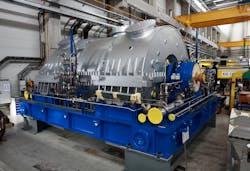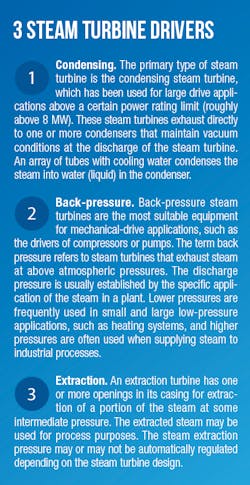Steam turbines are one of the oldest and most versatile prime mover technologies remaining in general use. They drive countless machines and produce power in many plants worldwide. Steam turbines have been in use for more than 120 years, when they replaced reciprocating steam engines because of their higher efficiencies and lower costs. The capacity of a steam turbine can range from 20 kilowatts to several hundred megawatts (MW) for large drivers.
A steam turbine is used to produce the maximum amount of mechanical power using the minimum amount of steam in a compact driver arrangement, usually in a direct-drive configuration. Speed variation or speed adjustment capabilities are also important for steam turbines. Currently, steam turbines are widely used in different driver applications for mechanical drives and power generation units and produce nearly 1 million (MW) of capacity worldwide.
The steam turbine rotor is the spinning component that has wheels and blades attached to it. The blade is the component that extracts energy from the steam.
Steam turbine designs and types
Two basic types of steam turbine designs are available. One is an impulse design in which the rotor turns as a result of the force of steam on the blades. The other is a reaction design, and it operates on the principle that the rotor derives its rotational force from the steam as it leaves the blades.
Steam usually enters at one end, travels in one direction toward the other end of the section and exits the casing to be reheated or passed on to the next section. A double-flow steam turbine, however, has steam entering in the middle and flowing in both directions toward the ends of the section. The double-flow arrangements were popular many years ago. Except for special circumstances, they are not recommended for modern applications.
Condensing
The primary type of steam turbine is the condensing steam turbine, which has been used for large drive applications above a certain power rating limit (say, as a very rough indication, above 8 MW). These steam turbines exhaust directly to one or more condensers that maintain vacuum conditions at the discharge of the steam turbine. An array of tubes with cooling water condenses the steam into water (liquid) in the condenser.
The condenser vacuum occurs as the near-ambient cooling water condenses the steam (the turbine exhaust) in the condenser. Because a small amount of air is known to leak into the system when it is below atmospheric pressure, a relatively small compressor is usually used to remove non-condensable gases from the condenser. Non-condensable gases may include air, a small amount of the corrosion byproduct caused by the water-iron reaction and hydrogen.
A condensing steam turbine’s processes produce the maximum mechanical power and efficiency from the steam supply. However, the power output of condensing steam turbines is sensitive to ambient temperature. Condensing steam turbines are expensive, large, complex and less suitable for mechanical drive applications. Steam turbines, especially for small or medium-sized machines, leak steam around blade rows and out the end seals. When an end is at low pressure, as is the case with condensing steam turbines, air can leak into the system. The leakages cause less power to be produced than expected.
Back-pressure
Another steam turbine type is a back-pressure steam turbine, which is the most suitable equipment for mechanical-drive applications, such as the drivers of compressors or pumps. The term back pressure refers to steam turbines that exhaust steam at above atmospheric pressures. The discharge pressure is usually established by the specific application of the steam in a plant. Lower pressures are frequently used in small and large low-pressure (LP) applications, such as heating systems, and higher pressures are often used when supplying steam to industrial processes.
Industrial processes often include further expansion for other smaller mechanical drives, using small steam turbines for driving rotating equipment (for instance, lubrication oil pumps) that continuously runs for long periods. Significant mechanical power generation capability is sacrificed when steam is used at appreciable pressure rather than being expanded to vacuum in a condenser. Discharging steam into a steam distribution system at 10 Bar gauge (barg) can sacrifice around half the power that could be generated when the inlet steam conditions are around 50 barg and 420°C, typical of small and medium steam turbines.
Between the mechanical power output of a condensing steam turbine and the power and steam combination of a back-pressure steam turbine, essentially any ratio of power-to-heat output can be supplied. Back-pressure steam turbines can have many different back pressures, further increasing the variability of the power-to-heat ratio.
Extraction
A third steam turbine type is extraction steam turbines. An extraction turbine has one or more openings in its casing for extraction of a portion of the steam at some intermediate pressure. The extracted steam may be used for process purposes. The steam extraction pressure may or may not be automatically regulated depending on the steam turbine design.
Regulated extraction allows for better steam flow adjustments through the steam turbine to generate additional mechanical power depending on the operating scenarios. In some special steam turbines, several extraction points may be included, each at a different pressure corresponding to a different temperature at which heating service (or other services) is needed in a plant.
The facility’s specific needs for steam and power over time determine the extent of the steam extraction. In large, often complex, plants, additional steam may be admitted (flow into the casing and increases the flow in the steam path) to the steam turbine. Often this happens when multiple boilers and steam generation systems are used at different pressures because of the plant’s complexity and the need to reach the utmost thermal efficiency or its historical existence (in complex plants that have been subjected to several renovations and expansions). These steam turbines are referred to as admission steam turbines. Manufacturers have tailored clients’ design requests by varying the flow area in the stages and the extent to which steam is extracted (or removed from the flow path between stages) to accommodate the specifications. At steam extraction and admission locations, steam flow control valves usually add to the steam and control system cost.
When the steam is expanded through a high-pressure ratio, as in large steam turbines, the steam can begin to condense in the turbine when the temperature of the steam drops below the saturation temperature at that pressure. If water drops form in the steam turbine, blade erosion would occur when the drops impact the blades. At this point in the expansion, the steam is sometimes returned to the boiler and reheated to a high temperature and then returned to the steam turbine for further (safe and reliable) expansion. In a few large, extremely high-pressure steam turbine systems, double reheat systems can also be installed.
Steam turbines with extraction and admission are special machines, and they should only be used for applications in which they are really needed since their operation and the control of the whole system are complicated and sometimes may result in operational problems. Steam turbines using extraction and admission are complex turbomachines with complicated control and operation that should simultaneously manage steam turbines (often variable load) with different steam flow controls based on other units and system requirements. They should only be used in special, large facilities in which other simpler steam turbines cannot be commercially competitive with respect to their powers, thermal efficiencies or other considerations. Usually, using a complex steam turbine with extraction and admission is not justified for a service with a few megawatts of power and complex patterns of variable-load, variable-speed steam turbine operation.
Steam flow, operation & design
Steam is first heated in a steam generation system (for example, in boilers or waste heat recovery systems), where it reaches a high temperature, around 400°C to 600°C. The first valve that the steam encounters as it travels from the steam generation system to the steam turbine is the main stop valve (main trip or shutdown valve), which is either fully opened or fully closed. This valve often does not control the steam flow other than to completely stop it.
Figure 2. Another example of a steam turbine, with internals, components and sub-systems, is shown.
Control or throttling valves in different arrangements and configurations are also used to control the steam inlet. Combined trip and throttle valves are also common. In many steam turbines, at least two independent trip valves should be provided for proper redundancy. These valves are immediately ahead of the steam turbine and are designed to withstand the full temperature and pressure of the steam. These valves are necessary because, if the mechanical load is lost, the steam turbine would rapidly over-speed and destroy itself. This is an occasional occurrence. An unusual root-cause, such as coupling failure, might result in this. Other accidents are possible, supporting the need for two or three independent stop valves, which bring safety and reliability but add cost to the system.
Steam turbine drives are equipped with throttling valves or nozzle governors to modulate steam flow and achieve variable speed operation. The steam turbine drive is capable of serving the same function as a variable speed drive electric motor driver. Steam turbines can usually operate across a broad speed range and do not fail when overloaded. They also produce the high starting torque required for constant torque loads such as with positive displacement pumps or compressors.
The steam hits the first row of blades at pressures so high that it can produce torque with just a small surface area. The steam’s impact causes the rotor to turn. As the steam turbine stages progress, however, the steam loses pressure and energy, therefore, requiring increasingly large surface areas. For this reason, the blades’ sizes increase with each stage. When the steam leaves the turbine, its temperature has dropped, and it has lost almost all its elevated pressure. Some of the pressure drop also occurs across the diaphragm, which is a component between the outer wall and inner web. The diaphragm’s partitions direct the steam toward the rotating blades.
The steam should strike the blades at a specific angle that will maximize the useful work of the steam’s pressure. This is where nozzles come into play. Stationary rings of nozzles are placed between the blade wheels to “turn” the steam at the optimal angle for striking the blades. A thrust bearing is mounted at one end of the main shaft to maintain its axial position and keep the moving parts from colliding with the stationary parts. The journal bearing supports the main shaft and restricts it from springing out of its casing at high speeds.
An exhaust hood guides steam from the last stage of the steam turbine, and it is designed to minimize pressure loss, which would decrease the thermal efficiency of the steam turbine. After the steam leaves the exhaust section, it enters a condenser, where it is cooled to a liquid state. The process of condensing the steam usually creates a vacuum, which then brings in more steam from the steam turbine. The water is returned to the steam generation system, reheated and reused. The governor is a device that controls the turbine’s speed. Modern steam turbines have an electronic governor that uses sensors to monitor the speed by examining the rotor teeth.
To design a more efficient steam turbine, a casing with proper nozzles and vanes to confine the steam and valves to control the admission of steam to the nozzles should be used. The thick-walled castings used for the pressure-containing turbine sections are called shells and are usually made from alloy steel materials. Some designs include inner and outer shells, which serve to balance the pressure drop and reduce the shell’s thickness for thermal stress, starting and loading. Multistage designs are used to increase efficiency. The type and number of turbine stages and the shape and size of the blades vary. They are determined based on the steam pressure and temperature, the exhaust pressure, and the speed.
When the steam turbine’s rotor is stationary, the steam flowing through the nozzle will hit the blades with full force, exerting the greatest amount of torque. However, since this occurs while the rotor is at a standstill, the work carried out is zero. On the other hand, if the speed of the rotor is equal to that of the steam, the steam will have no velocity component relative to the blades, and the blades will not turn. Therefore, this case leads to zero torque and, once again, zero work. The maximum efficiency occurs between these two extremes. Proper optimization should be carried out to reach ideal operating conditions and peak efficiency.
Because of the high pressures used in steam turbines, the casing is quite thick, and consequently steam turbines exhibit large thermal inertia. They should be warmed up and cooled down slowly to minimize the differential expansion between the rotating blades and the stationary components. Large steam turbines may require approximately five to nine hours to warm up. While smaller units have more rapid start-up times, steam turbines differ appreciably from reciprocating engines, which start up rapidly, and from gas turbines, which can start up in a moderate amount of time and load follow with reasonable rapidity.
Steam turbine applications usually operate continuously for extended periods of time, even though the steam fed to the unit and the mechanical power delivered may vary during such periods of continuous operation. Because most steam turbines are selected for applications with high-duty factors, the nature of their application often takes care of the need to have only slow temperature changes during operation, and long startup times can be tolerated. Steam boilers similarly have long startup times.
Flow, deterioration & degradation
Impurities in the steam may cause deposits, scale and corrosion in steam turbines that adversely affect their operation. The three most important corrosion-related failure mechanisms in any low-pressure steam turbine are pitting, corrosion fatigue and stress corrosion cracking. The local steam environment determines whether these damage mechanisms occur on blade and disk surfaces.
The phase transition zone, where the expansion and cooling of the steam leads to condensation, is particularly important. A number of processes that take place in this zone — such as precipitation of chemical compounds from superheated steam, deposition, evaporation, and drying of liquid films on hot surfaces — lead to the formation of potentially corrosive surface deposits.
Steam purity and shutdown conditions are two of the parameters that lead to corrosion damage. The environmental conditions produced during shutdown can be another important factor. These are the conditions that occur during unprotected shutdown when oxygenated moist and liquid films form on steam path surfaces as a result of hygroscopic effects. These films are directly caused by inadequate shutdown practices adopted by a steam turbine operation/maintenance team or overall team. They can lead to pitting, which is most often the precursor to the corrosion mechanisms.
Adequate material properties (such as composition, structure and internal stresses) and design (temperature, stresses and crevices) also play essential roles. Pitting may also initiate during operation in crevices, such as blade attachments. The purity of steam controls most corrosion processes and is vital to steam turbine reliability.
Mechanical blockages might occur as a result of deposits. Although rare, blockages at sensitive locations usually have severe consequences. For example, even small deposits on the stem of a steam turbine check valve can interfere with its function. In the event of a steam turbine trip, a malfunctioning check valve may lead to continued steam flow, and some damage to the turbine. Also, deposits on stationary parts, if thick and strong enough, may impede blade movement, presenting a particular risk of mechanical damage to small blades.
Plugging of the steam flow path changes the pressure relations in the steam turbine in a way that can cause an axial shift of the shaft. This can lead to contact between rotating and stationary parts, with the potential for severe failure. Such conditions are often detected and avoided by monitoring the steam turbine pressures.
A more frequent, but less consequential result of a steam flow blockage is a reduction of the flow passing ability (swallowing capacity) of the steam turbine and the change in effective steam flow profile on the steam turbine blades. These changes result in steam flow reduction, reduced power output and degradation of the turbine’s efficiency. Common examples are deposits of copper and aluminum in high-pressure steam turbines and silica deposits in medium-pressure and low-pressure turbines.
Amin Almasi is a senior rotating machinery consultant in Australia. He is a chartered professional engineer of Engineers Australia and IMechE and holds bachelor’s and master’s degrees in mechanical engineering and RPEQ. He is an active member of Engineers Australia, IMechE, ASME and SPE and has authored more than 100 papers and articles dealing with rotating equipment, condition monitoring, offshore, subsea and reliability.




